Midtown Family Clinic: EHR System Introduction and Analysis Report
VerifiedAdded on 2019/10/18
|22
|4093
|283
Report
AI Summary
This report analyzes the current operational procedures of Midtown Family Clinic and proposes a suitable Electronic Health Record (EHR) system. The report is divided into four parts. The first part assesses the organization's goals, including operational efficiency, financial profit, and clinic expansion, and outlines the components of the information system, such as people, organizational processes (appointment scheduling, billing, and patient record management), and data/information requirements. The second part focuses on data sharing with external organizations, specifically laboratories and health insurance providers, detailing data types and data interchange standards. The third part addresses ethical, legal, and regulatory policy issues related to EHR implementation. The report identifies twenty ethical, legal, and regulatory policy issues and discusses the most difficult one. The final part recommends a suitable EHR system for the clinic based on the analysis. The report emphasizes the strategic use of technology to automate processes, improve patient care, and increase efficiency within the clinic.

EHR System
Introduction and Section I + II
Introduction and Section I + II
Paraphrase This Document
Need a fresh take? Get an instant paraphrase of this document with our AI Paraphraser
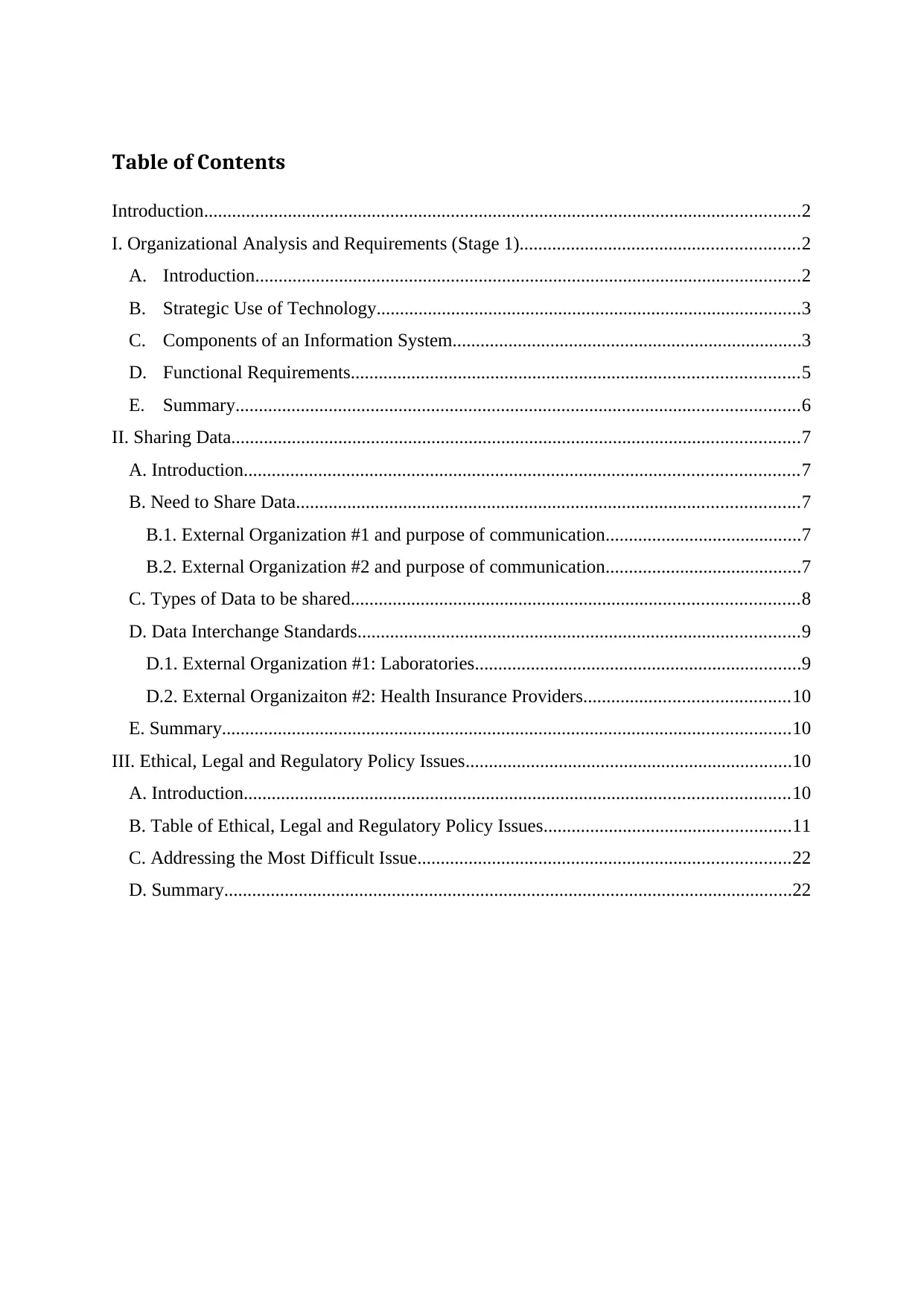
Table of Contents
Introduction................................................................................................................................2
I. Organizational Analysis and Requirements (Stage 1)............................................................2
A. Introduction.....................................................................................................................2
B. Strategic Use of Technology...........................................................................................3
C. Components of an Information System...........................................................................3
D. Functional Requirements................................................................................................5
E. Summary.........................................................................................................................6
II. Sharing Data..........................................................................................................................7
A. Introduction.......................................................................................................................7
B. Need to Share Data............................................................................................................7
B.1. External Organization #1 and purpose of communication..........................................7
B.2. External Organization #2 and purpose of communication..........................................7
C. Types of Data to be shared................................................................................................8
D. Data Interchange Standards...............................................................................................9
D.1. External Organization #1: Laboratories......................................................................9
D.2. External Organizaiton #2: Health Insurance Providers............................................10
E. Summary..........................................................................................................................10
III. Ethical, Legal and Regulatory Policy Issues......................................................................10
A. Introduction.....................................................................................................................10
B. Table of Ethical, Legal and Regulatory Policy Issues.....................................................11
C. Addressing the Most Difficult Issue................................................................................22
D. Summary..........................................................................................................................22
Introduction................................................................................................................................2
I. Organizational Analysis and Requirements (Stage 1)............................................................2
A. Introduction.....................................................................................................................2
B. Strategic Use of Technology...........................................................................................3
C. Components of an Information System...........................................................................3
D. Functional Requirements................................................................................................5
E. Summary.........................................................................................................................6
II. Sharing Data..........................................................................................................................7
A. Introduction.......................................................................................................................7
B. Need to Share Data............................................................................................................7
B.1. External Organization #1 and purpose of communication..........................................7
B.2. External Organization #2 and purpose of communication..........................................7
C. Types of Data to be shared................................................................................................8
D. Data Interchange Standards...............................................................................................9
D.1. External Organization #1: Laboratories......................................................................9
D.2. External Organizaiton #2: Health Insurance Providers............................................10
E. Summary..........................................................................................................................10
III. Ethical, Legal and Regulatory Policy Issues......................................................................10
A. Introduction.....................................................................................................................10
B. Table of Ethical, Legal and Regulatory Policy Issues.....................................................11
C. Addressing the Most Difficult Issue................................................................................22
D. Summary..........................................................................................................................22
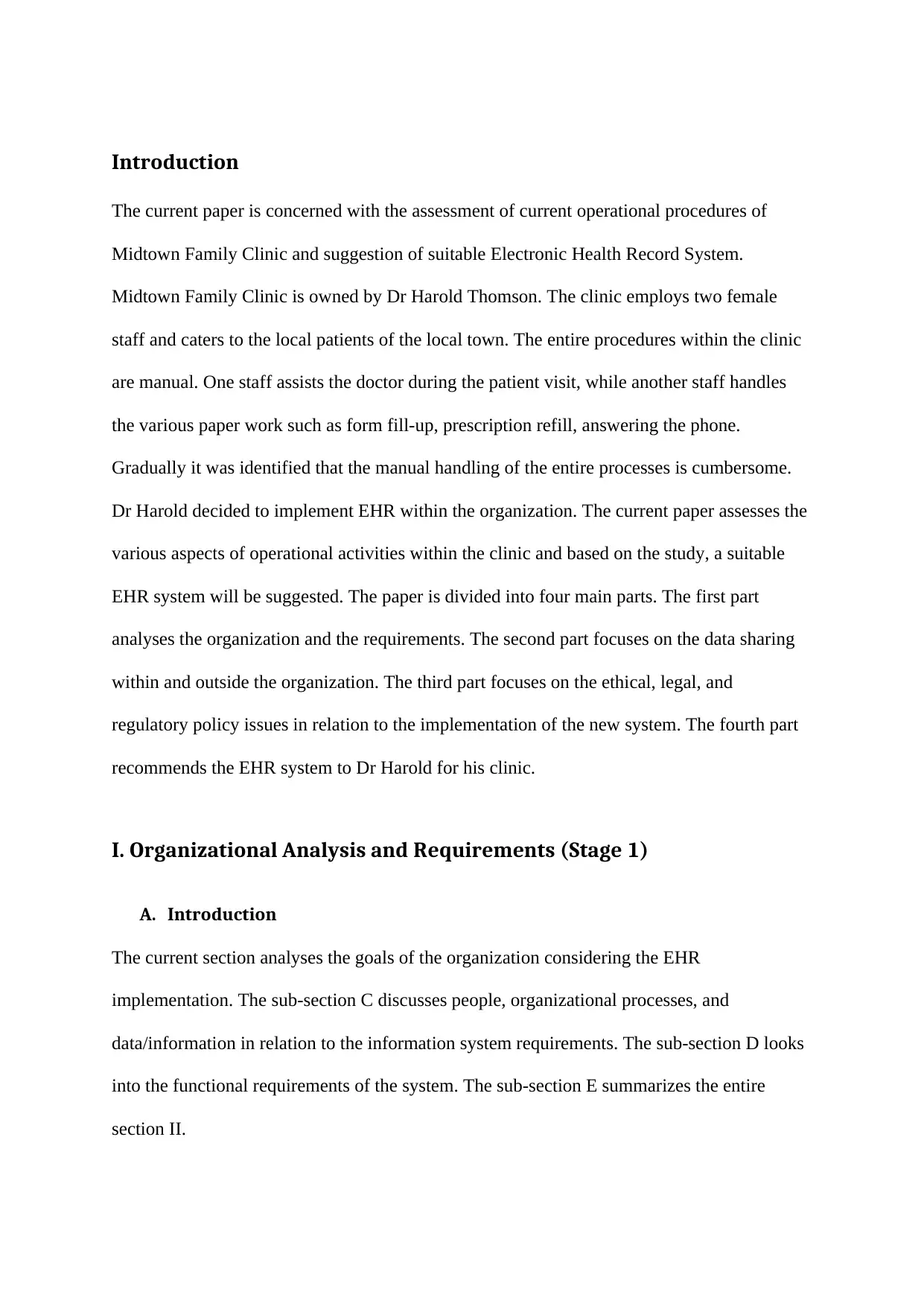
Introduction
The current paper is concerned with the assessment of current operational procedures of
Midtown Family Clinic and suggestion of suitable Electronic Health Record System.
Midtown Family Clinic is owned by Dr Harold Thomson. The clinic employs two female
staff and caters to the local patients of the local town. The entire procedures within the clinic
are manual. One staff assists the doctor during the patient visit, while another staff handles
the various paper work such as form fill-up, prescription refill, answering the phone.
Gradually it was identified that the manual handling of the entire processes is cumbersome.
Dr Harold decided to implement EHR within the organization. The current paper assesses the
various aspects of operational activities within the clinic and based on the study, a suitable
EHR system will be suggested. The paper is divided into four main parts. The first part
analyses the organization and the requirements. The second part focuses on the data sharing
within and outside the organization. The third part focuses on the ethical, legal, and
regulatory policy issues in relation to the implementation of the new system. The fourth part
recommends the EHR system to Dr Harold for his clinic.
I. Organizational Analysis and Requirements (Stage 1)
A. Introduction
The current section analyses the goals of the organization considering the EHR
implementation. The sub-section C discusses people, organizational processes, and
data/information in relation to the information system requirements. The sub-section D looks
into the functional requirements of the system. The sub-section E summarizes the entire
section II.
The current paper is concerned with the assessment of current operational procedures of
Midtown Family Clinic and suggestion of suitable Electronic Health Record System.
Midtown Family Clinic is owned by Dr Harold Thomson. The clinic employs two female
staff and caters to the local patients of the local town. The entire procedures within the clinic
are manual. One staff assists the doctor during the patient visit, while another staff handles
the various paper work such as form fill-up, prescription refill, answering the phone.
Gradually it was identified that the manual handling of the entire processes is cumbersome.
Dr Harold decided to implement EHR within the organization. The current paper assesses the
various aspects of operational activities within the clinic and based on the study, a suitable
EHR system will be suggested. The paper is divided into four main parts. The first part
analyses the organization and the requirements. The second part focuses on the data sharing
within and outside the organization. The third part focuses on the ethical, legal, and
regulatory policy issues in relation to the implementation of the new system. The fourth part
recommends the EHR system to Dr Harold for his clinic.
I. Organizational Analysis and Requirements (Stage 1)
A. Introduction
The current section analyses the goals of the organization considering the EHR
implementation. The sub-section C discusses people, organizational processes, and
data/information in relation to the information system requirements. The sub-section D looks
into the functional requirements of the system. The sub-section E summarizes the entire
section II.
⊘ This is a preview!⊘
Do you want full access?
Subscribe today to unlock all pages.

Trusted by 1+ million students worldwide
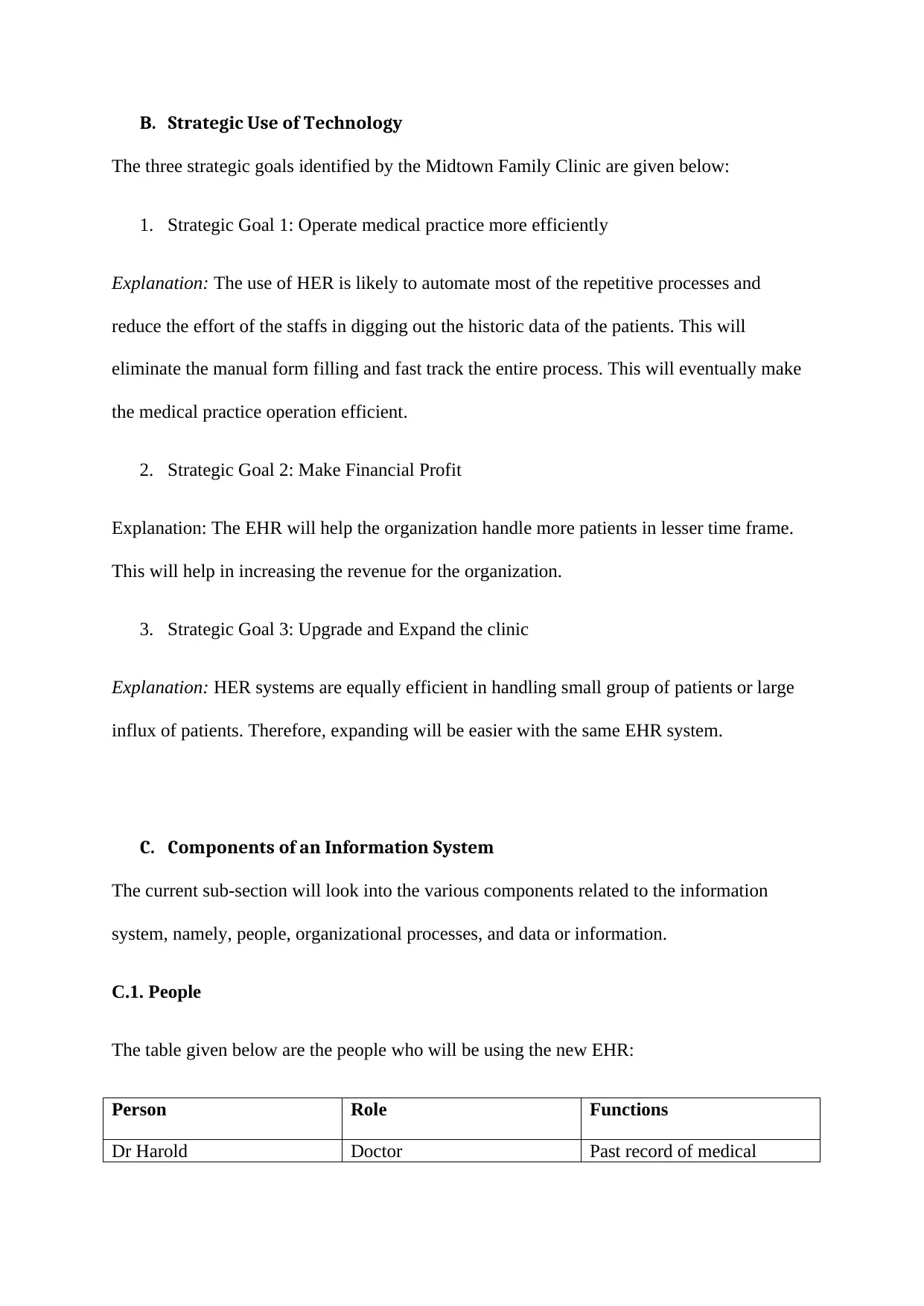
B. Strategic Use of Technology
The three strategic goals identified by the Midtown Family Clinic are given below:
1. Strategic Goal 1: Operate medical practice more efficiently
Explanation: The use of HER is likely to automate most of the repetitive processes and
reduce the effort of the staffs in digging out the historic data of the patients. This will
eliminate the manual form filling and fast track the entire process. This will eventually make
the medical practice operation efficient.
2. Strategic Goal 2: Make Financial Profit
Explanation: The EHR will help the organization handle more patients in lesser time frame.
This will help in increasing the revenue for the organization.
3. Strategic Goal 3: Upgrade and Expand the clinic
Explanation: HER systems are equally efficient in handling small group of patients or large
influx of patients. Therefore, expanding will be easier with the same EHR system.
C. Components of an Information System
The current sub-section will look into the various components related to the information
system, namely, people, organizational processes, and data or information.
C.1. People
The table given below are the people who will be using the new EHR:
Person Role Functions
Dr Harold Doctor Past record of medical
The three strategic goals identified by the Midtown Family Clinic are given below:
1. Strategic Goal 1: Operate medical practice more efficiently
Explanation: The use of HER is likely to automate most of the repetitive processes and
reduce the effort of the staffs in digging out the historic data of the patients. This will
eliminate the manual form filling and fast track the entire process. This will eventually make
the medical practice operation efficient.
2. Strategic Goal 2: Make Financial Profit
Explanation: The EHR will help the organization handle more patients in lesser time frame.
This will help in increasing the revenue for the organization.
3. Strategic Goal 3: Upgrade and Expand the clinic
Explanation: HER systems are equally efficient in handling small group of patients or large
influx of patients. Therefore, expanding will be easier with the same EHR system.
C. Components of an Information System
The current sub-section will look into the various components related to the information
system, namely, people, organizational processes, and data or information.
C.1. People
The table given below are the people who will be using the new EHR:
Person Role Functions
Dr Harold Doctor Past record of medical
Paraphrase This Document
Need a fresh take? Get an instant paraphrase of this document with our AI Paraphraser
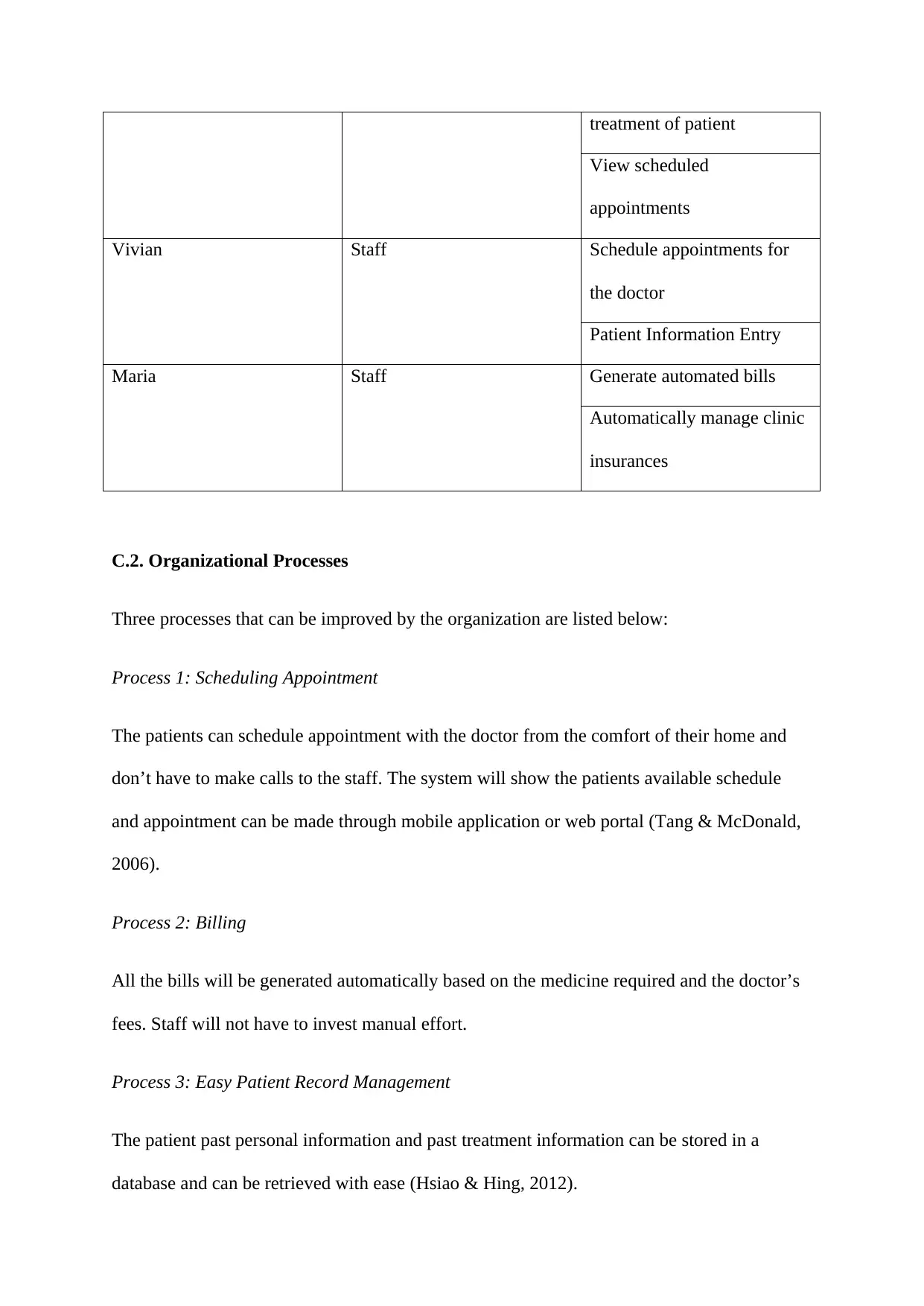
treatment of patient
View scheduled
appointments
Vivian Staff Schedule appointments for
the doctor
Patient Information Entry
Maria Staff Generate automated bills
Automatically manage clinic
insurances
C.2. Organizational Processes
Three processes that can be improved by the organization are listed below:
Process 1: Scheduling Appointment
The patients can schedule appointment with the doctor from the comfort of their home and
don’t have to make calls to the staff. The system will show the patients available schedule
and appointment can be made through mobile application or web portal (Tang & McDonald,
2006).
Process 2: Billing
All the bills will be generated automatically based on the medicine required and the doctor’s
fees. Staff will not have to invest manual effort.
Process 3: Easy Patient Record Management
The patient past personal information and past treatment information can be stored in a
database and can be retrieved with ease (Hsiao & Hing, 2012).
View scheduled
appointments
Vivian Staff Schedule appointments for
the doctor
Patient Information Entry
Maria Staff Generate automated bills
Automatically manage clinic
insurances
C.2. Organizational Processes
Three processes that can be improved by the organization are listed below:
Process 1: Scheduling Appointment
The patients can schedule appointment with the doctor from the comfort of their home and
don’t have to make calls to the staff. The system will show the patients available schedule
and appointment can be made through mobile application or web portal (Tang & McDonald,
2006).
Process 2: Billing
All the bills will be generated automatically based on the medicine required and the doctor’s
fees. Staff will not have to invest manual effort.
Process 3: Easy Patient Record Management
The patient past personal information and past treatment information can be stored in a
database and can be retrieved with ease (Hsiao & Hing, 2012).
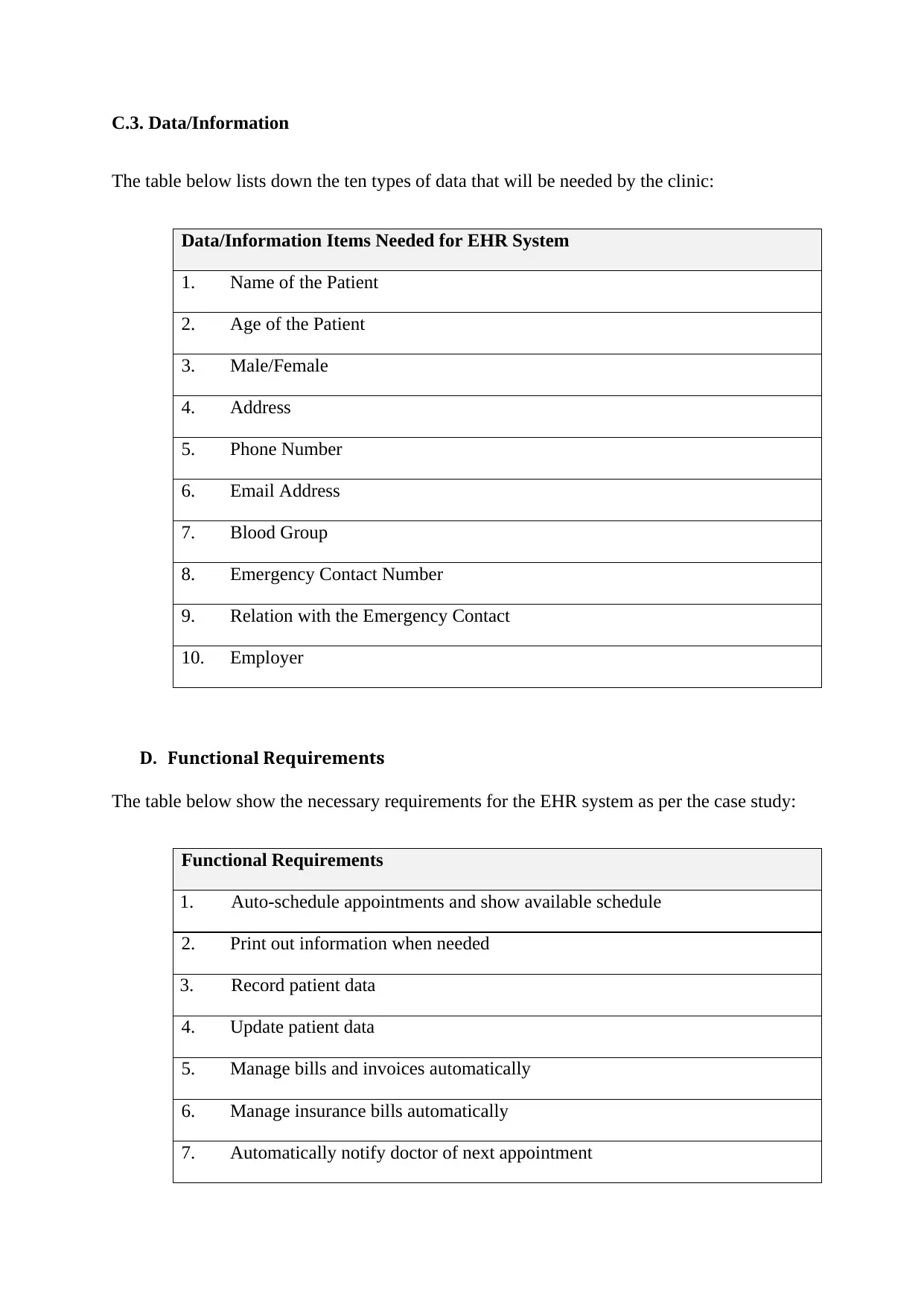
C.3. Data/Information
The table below lists down the ten types of data that will be needed by the clinic:
Data/Information Items Needed for EHR System
1. Name of the Patient
2. Age of the Patient
3. Male/Female
4. Address
5. Phone Number
6. Email Address
7. Blood Group
8. Emergency Contact Number
9. Relation with the Emergency Contact
10. Employer
D. Functional Requirements
The table below show the necessary requirements for the EHR system as per the case study:
Functional Requirements
1. Auto-schedule appointments and show available schedule
2. Print out information when needed
3. Record patient data
4. Update patient data
5. Manage bills and invoices automatically
6. Manage insurance bills automatically
7. Automatically notify doctor of next appointment
The table below lists down the ten types of data that will be needed by the clinic:
Data/Information Items Needed for EHR System
1. Name of the Patient
2. Age of the Patient
3. Male/Female
4. Address
5. Phone Number
6. Email Address
7. Blood Group
8. Emergency Contact Number
9. Relation with the Emergency Contact
10. Employer
D. Functional Requirements
The table below show the necessary requirements for the EHR system as per the case study:
Functional Requirements
1. Auto-schedule appointments and show available schedule
2. Print out information when needed
3. Record patient data
4. Update patient data
5. Manage bills and invoices automatically
6. Manage insurance bills automatically
7. Automatically notify doctor of next appointment
⊘ This is a preview!⊘
Do you want full access?
Subscribe today to unlock all pages.

Trusted by 1+ million students worldwide
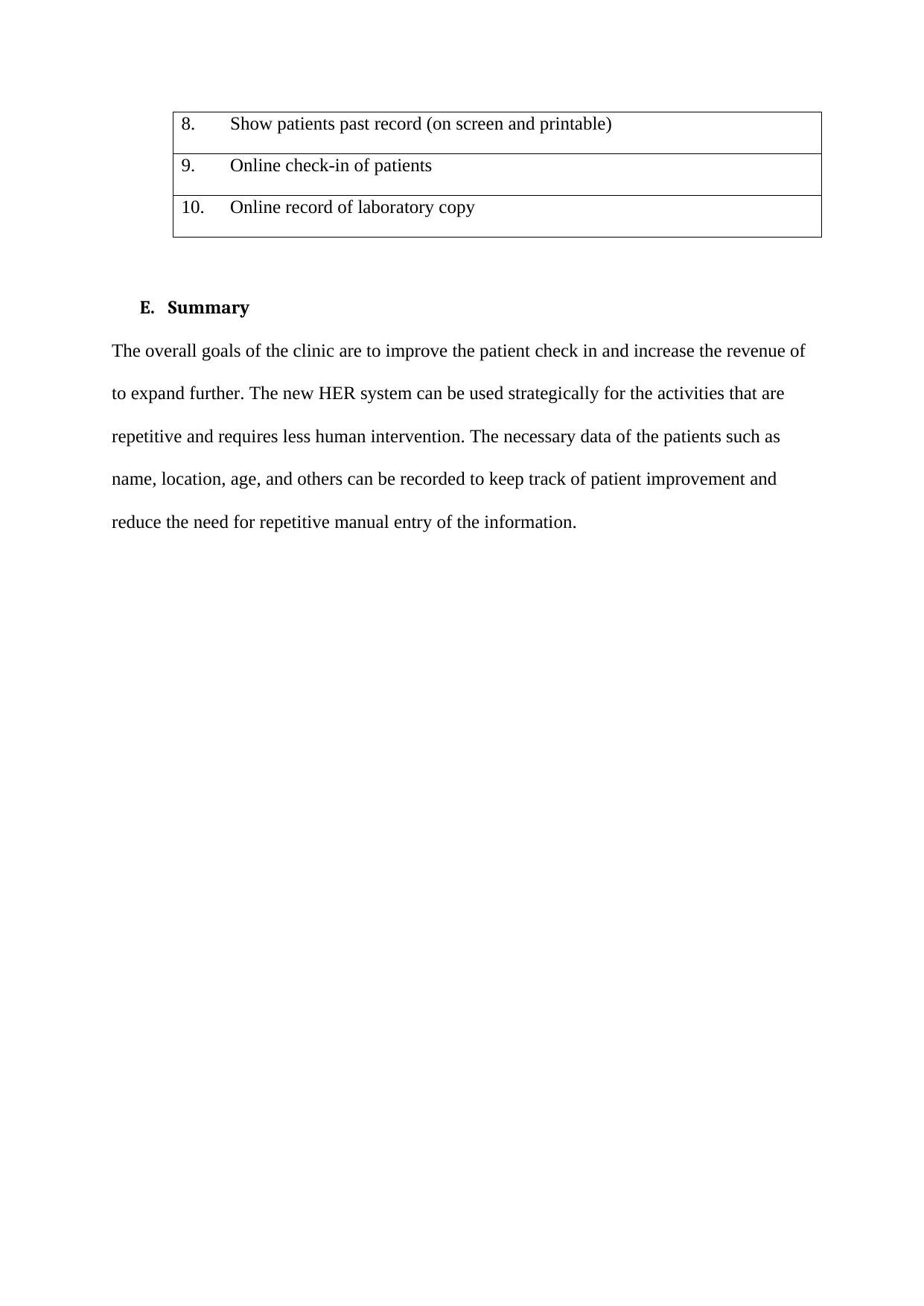
8. Show patients past record (on screen and printable)
9. Online check-in of patients
10. Online record of laboratory copy
E. Summary
The overall goals of the clinic are to improve the patient check in and increase the revenue of
to expand further. The new HER system can be used strategically for the activities that are
repetitive and requires less human intervention. The necessary data of the patients such as
name, location, age, and others can be recorded to keep track of patient improvement and
reduce the need for repetitive manual entry of the information.
9. Online check-in of patients
10. Online record of laboratory copy
E. Summary
The overall goals of the clinic are to improve the patient check in and increase the revenue of
to expand further. The new HER system can be used strategically for the activities that are
repetitive and requires less human intervention. The necessary data of the patients such as
name, location, age, and others can be recorded to keep track of patient improvement and
reduce the need for repetitive manual entry of the information.
Paraphrase This Document
Need a fresh take? Get an instant paraphrase of this document with our AI Paraphraser
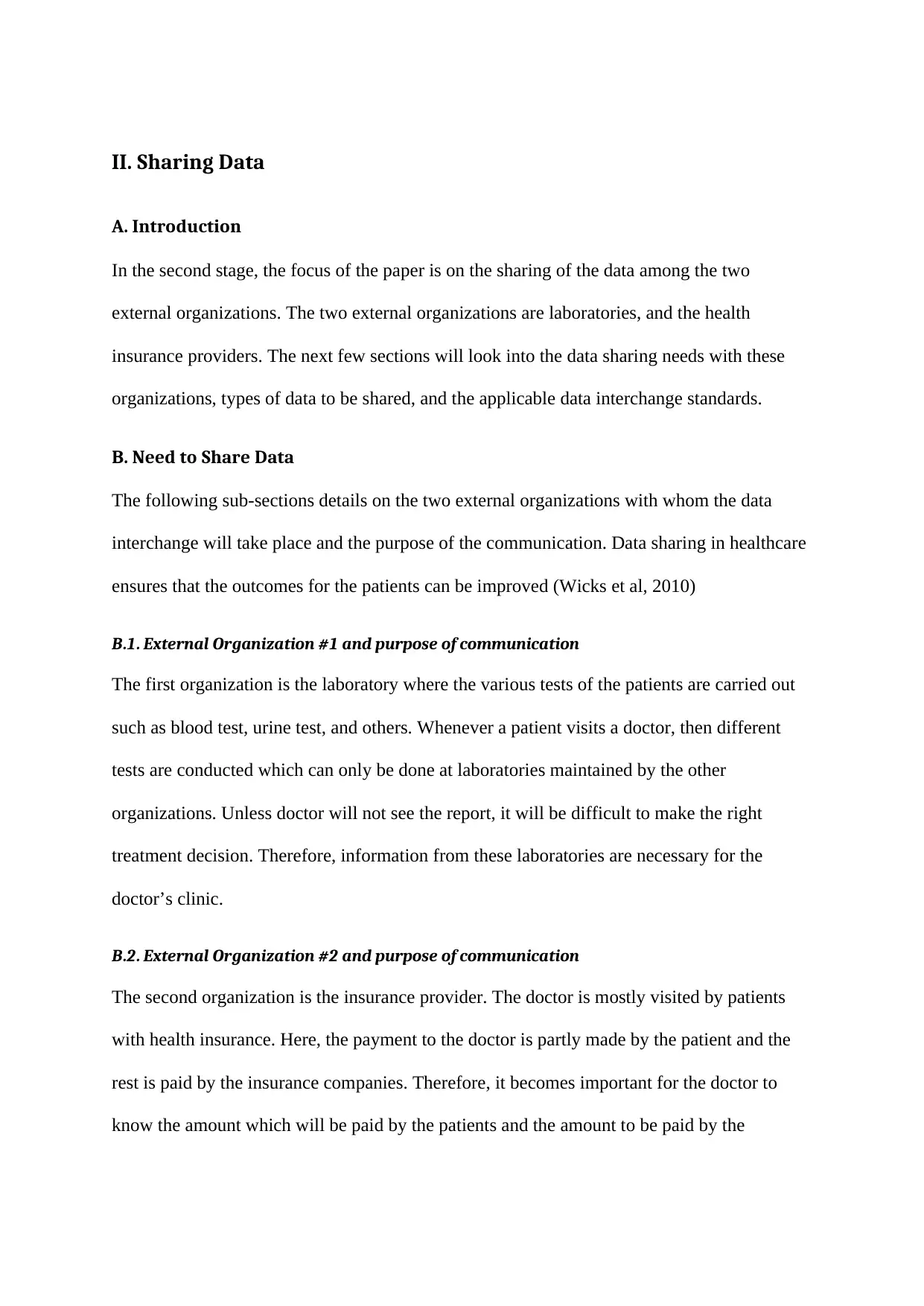
II. Sharing Data
A. Introduction
In the second stage, the focus of the paper is on the sharing of the data among the two
external organizations. The two external organizations are laboratories, and the health
insurance providers. The next few sections will look into the data sharing needs with these
organizations, types of data to be shared, and the applicable data interchange standards.
B. Need to Share Data
The following sub-sections details on the two external organizations with whom the data
interchange will take place and the purpose of the communication. Data sharing in healthcare
ensures that the outcomes for the patients can be improved (Wicks et al, 2010)
B.1. External Organization #1 and purpose of communication
The first organization is the laboratory where the various tests of the patients are carried out
such as blood test, urine test, and others. Whenever a patient visits a doctor, then different
tests are conducted which can only be done at laboratories maintained by the other
organizations. Unless doctor will not see the report, it will be difficult to make the right
treatment decision. Therefore, information from these laboratories are necessary for the
doctor’s clinic.
B.2. External Organization #2 and purpose of communication
The second organization is the insurance provider. The doctor is mostly visited by patients
with health insurance. Here, the payment to the doctor is partly made by the patient and the
rest is paid by the insurance companies. Therefore, it becomes important for the doctor to
know the amount which will be paid by the patients and the amount to be paid by the
A. Introduction
In the second stage, the focus of the paper is on the sharing of the data among the two
external organizations. The two external organizations are laboratories, and the health
insurance providers. The next few sections will look into the data sharing needs with these
organizations, types of data to be shared, and the applicable data interchange standards.
B. Need to Share Data
The following sub-sections details on the two external organizations with whom the data
interchange will take place and the purpose of the communication. Data sharing in healthcare
ensures that the outcomes for the patients can be improved (Wicks et al, 2010)
B.1. External Organization #1 and purpose of communication
The first organization is the laboratory where the various tests of the patients are carried out
such as blood test, urine test, and others. Whenever a patient visits a doctor, then different
tests are conducted which can only be done at laboratories maintained by the other
organizations. Unless doctor will not see the report, it will be difficult to make the right
treatment decision. Therefore, information from these laboratories are necessary for the
doctor’s clinic.
B.2. External Organization #2 and purpose of communication
The second organization is the insurance provider. The doctor is mostly visited by patients
with health insurance. Here, the payment to the doctor is partly made by the patient and the
rest is paid by the insurance companies. Therefore, it becomes important for the doctor to
know the amount which will be paid by the patients and the amount to be paid by the
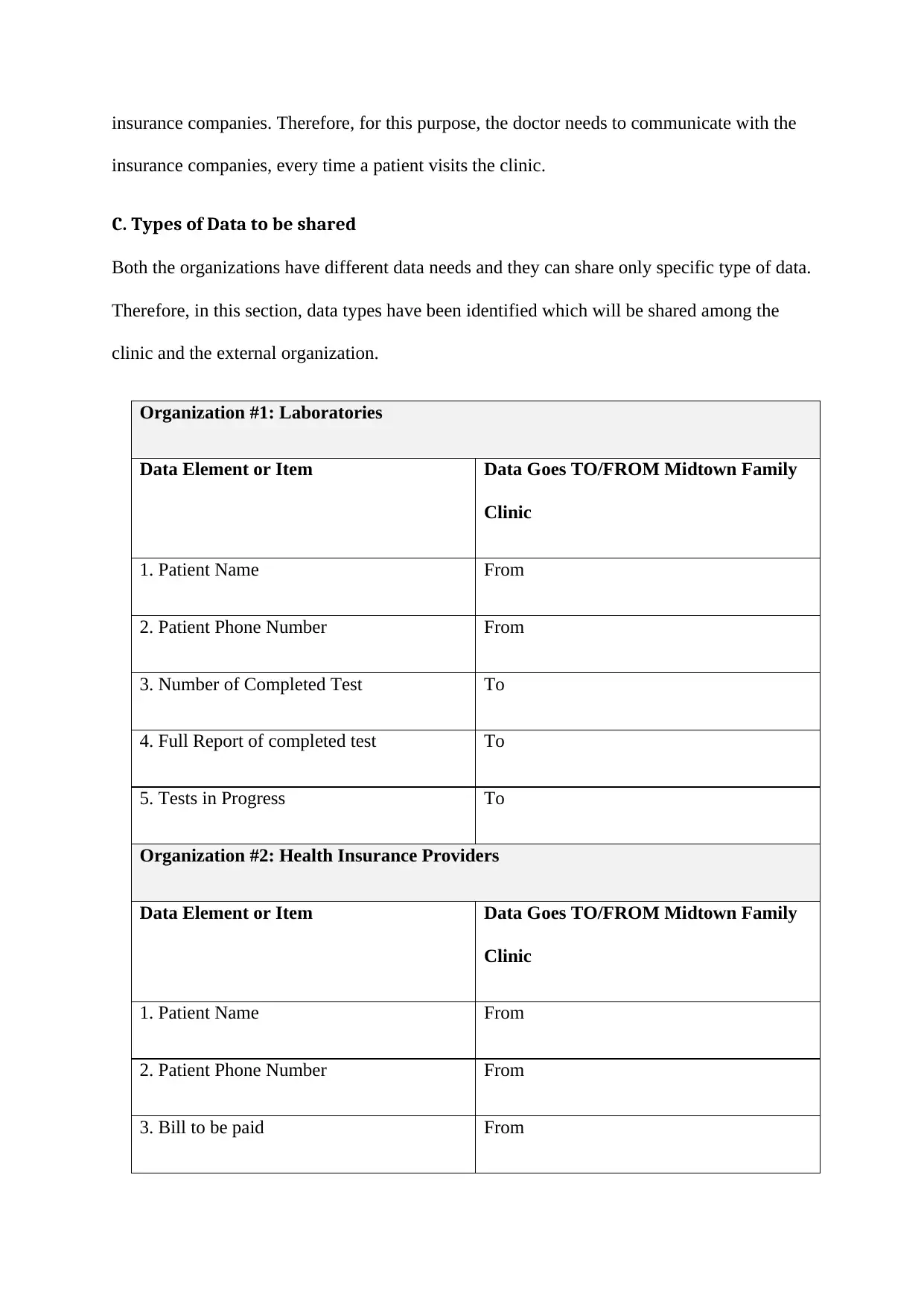
insurance companies. Therefore, for this purpose, the doctor needs to communicate with the
insurance companies, every time a patient visits the clinic.
C. Types of Data to be shared
Both the organizations have different data needs and they can share only specific type of data.
Therefore, in this section, data types have been identified which will be shared among the
clinic and the external organization.
Organization #1: Laboratories
Data Element or Item Data Goes TO/FROM Midtown Family
Clinic
1. Patient Name From
2. Patient Phone Number From
3. Number of Completed Test To
4. Full Report of completed test To
5. Tests in Progress To
Organization #2: Health Insurance Providers
Data Element or Item Data Goes TO/FROM Midtown Family
Clinic
1. Patient Name From
2. Patient Phone Number From
3. Bill to be paid From
insurance companies, every time a patient visits the clinic.
C. Types of Data to be shared
Both the organizations have different data needs and they can share only specific type of data.
Therefore, in this section, data types have been identified which will be shared among the
clinic and the external organization.
Organization #1: Laboratories
Data Element or Item Data Goes TO/FROM Midtown Family
Clinic
1. Patient Name From
2. Patient Phone Number From
3. Number of Completed Test To
4. Full Report of completed test To
5. Tests in Progress To
Organization #2: Health Insurance Providers
Data Element or Item Data Goes TO/FROM Midtown Family
Clinic
1. Patient Name From
2. Patient Phone Number From
3. Bill to be paid From
⊘ This is a preview!⊘
Do you want full access?
Subscribe today to unlock all pages.

Trusted by 1+ million students worldwide
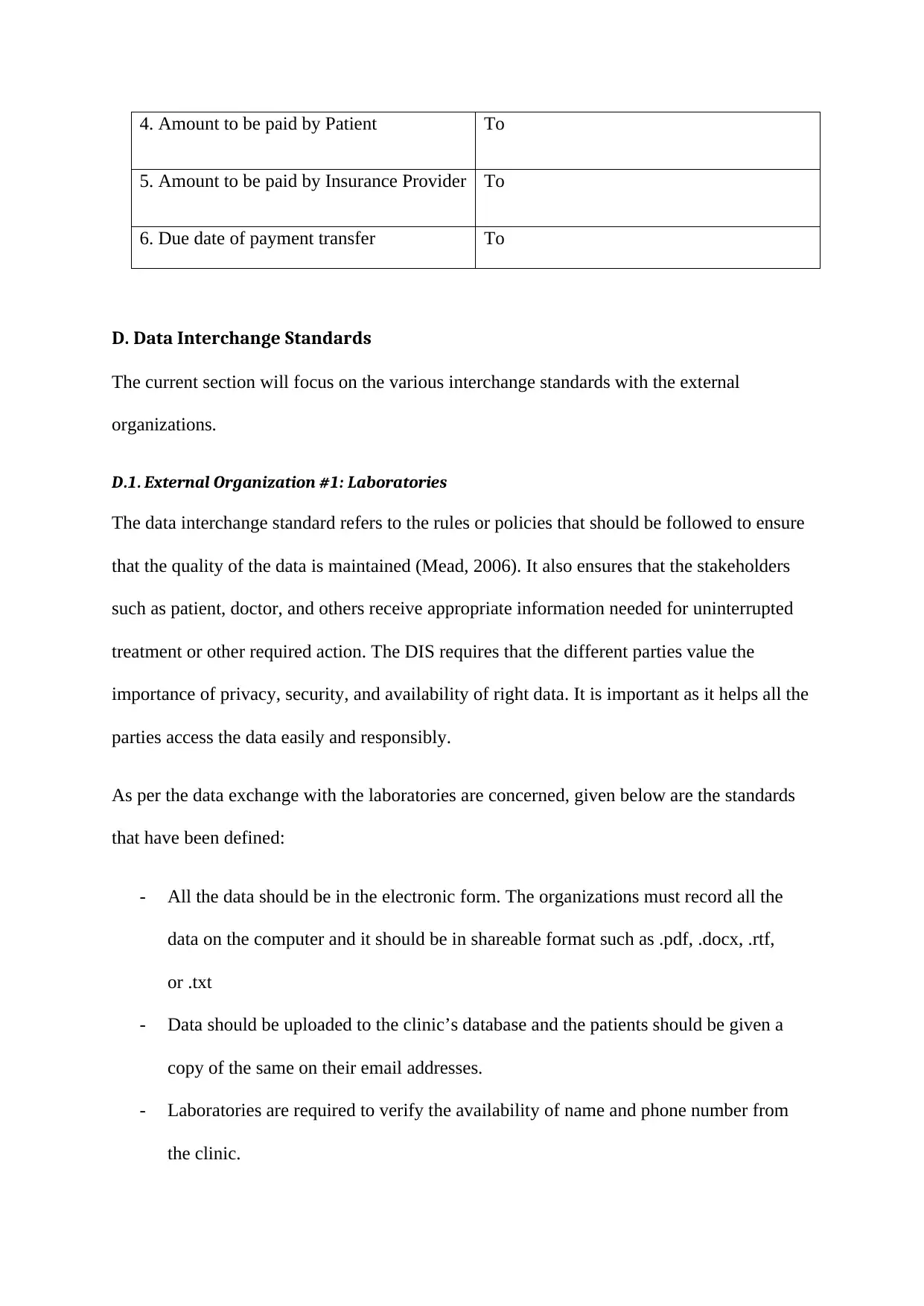
4. Amount to be paid by Patient To
5. Amount to be paid by Insurance Provider To
6. Due date of payment transfer To
D. Data Interchange Standards
The current section will focus on the various interchange standards with the external
organizations.
D.1. External Organization #1: Laboratories
The data interchange standard refers to the rules or policies that should be followed to ensure
that the quality of the data is maintained (Mead, 2006). It also ensures that the stakeholders
such as patient, doctor, and others receive appropriate information needed for uninterrupted
treatment or other required action. The DIS requires that the different parties value the
importance of privacy, security, and availability of right data. It is important as it helps all the
parties access the data easily and responsibly.
As per the data exchange with the laboratories are concerned, given below are the standards
that have been defined:
- All the data should be in the electronic form. The organizations must record all the
data on the computer and it should be in shareable format such as .pdf, .docx, .rtf,
or .txt
- Data should be uploaded to the clinic’s database and the patients should be given a
copy of the same on their email addresses.
- Laboratories are required to verify the availability of name and phone number from
the clinic.
5. Amount to be paid by Insurance Provider To
6. Due date of payment transfer To
D. Data Interchange Standards
The current section will focus on the various interchange standards with the external
organizations.
D.1. External Organization #1: Laboratories
The data interchange standard refers to the rules or policies that should be followed to ensure
that the quality of the data is maintained (Mead, 2006). It also ensures that the stakeholders
such as patient, doctor, and others receive appropriate information needed for uninterrupted
treatment or other required action. The DIS requires that the different parties value the
importance of privacy, security, and availability of right data. It is important as it helps all the
parties access the data easily and responsibly.
As per the data exchange with the laboratories are concerned, given below are the standards
that have been defined:
- All the data should be in the electronic form. The organizations must record all the
data on the computer and it should be in shareable format such as .pdf, .docx, .rtf,
or .txt
- Data should be uploaded to the clinic’s database and the patients should be given a
copy of the same on their email addresses.
- Laboratories are required to verify the availability of name and phone number from
the clinic.
Paraphrase This Document
Need a fresh take? Get an instant paraphrase of this document with our AI Paraphraser
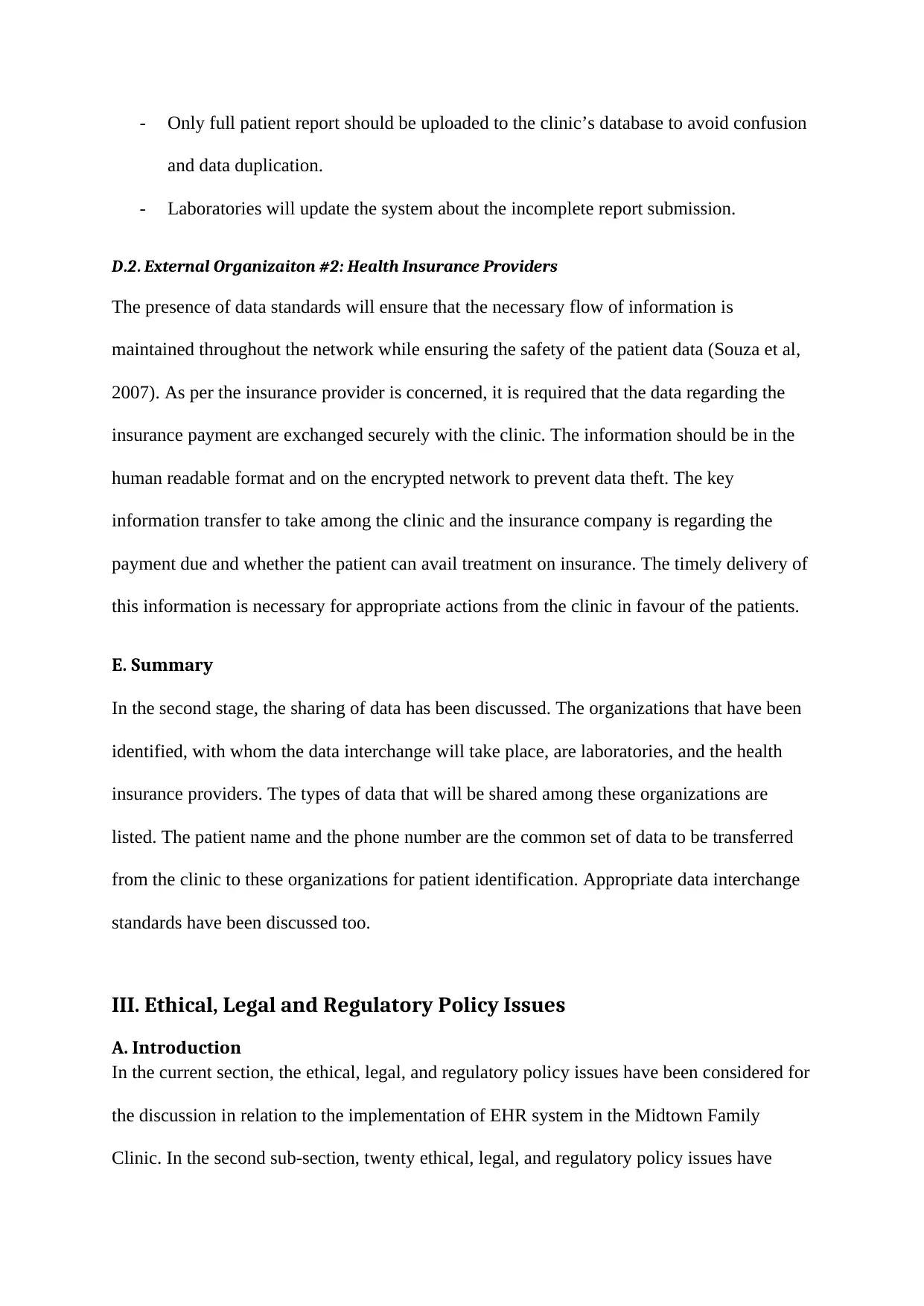
- Only full patient report should be uploaded to the clinic’s database to avoid confusion
and data duplication.
- Laboratories will update the system about the incomplete report submission.
D.2. External Organizaiton #2: Health Insurance Providers
The presence of data standards will ensure that the necessary flow of information is
maintained throughout the network while ensuring the safety of the patient data (Souza et al,
2007). As per the insurance provider is concerned, it is required that the data regarding the
insurance payment are exchanged securely with the clinic. The information should be in the
human readable format and on the encrypted network to prevent data theft. The key
information transfer to take among the clinic and the insurance company is regarding the
payment due and whether the patient can avail treatment on insurance. The timely delivery of
this information is necessary for appropriate actions from the clinic in favour of the patients.
E. Summary
In the second stage, the sharing of data has been discussed. The organizations that have been
identified, with whom the data interchange will take place, are laboratories, and the health
insurance providers. The types of data that will be shared among these organizations are
listed. The patient name and the phone number are the common set of data to be transferred
from the clinic to these organizations for patient identification. Appropriate data interchange
standards have been discussed too.
III. Ethical, Legal and Regulatory Policy Issues
A. Introduction
In the current section, the ethical, legal, and regulatory policy issues have been considered for
the discussion in relation to the implementation of EHR system in the Midtown Family
Clinic. In the second sub-section, twenty ethical, legal, and regulatory policy issues have
and data duplication.
- Laboratories will update the system about the incomplete report submission.
D.2. External Organizaiton #2: Health Insurance Providers
The presence of data standards will ensure that the necessary flow of information is
maintained throughout the network while ensuring the safety of the patient data (Souza et al,
2007). As per the insurance provider is concerned, it is required that the data regarding the
insurance payment are exchanged securely with the clinic. The information should be in the
human readable format and on the encrypted network to prevent data theft. The key
information transfer to take among the clinic and the insurance company is regarding the
payment due and whether the patient can avail treatment on insurance. The timely delivery of
this information is necessary for appropriate actions from the clinic in favour of the patients.
E. Summary
In the second stage, the sharing of data has been discussed. The organizations that have been
identified, with whom the data interchange will take place, are laboratories, and the health
insurance providers. The types of data that will be shared among these organizations are
listed. The patient name and the phone number are the common set of data to be transferred
from the clinic to these organizations for patient identification. Appropriate data interchange
standards have been discussed too.
III. Ethical, Legal and Regulatory Policy Issues
A. Introduction
In the current section, the ethical, legal, and regulatory policy issues have been considered for
the discussion in relation to the implementation of EHR system in the Midtown Family
Clinic. In the second sub-section, twenty ethical, legal, and regulatory policy issues have

been covered. In the third section, the most difficult issue among these twenty issues has been
picked and discussed. In the end, a summary has been provided.
B. Table of Ethical, Legal and Regulatory Policy Issues
Table of Ethical, Legal and Regulatory Policy Issues
Topic Definition of the Topic
How the topic impacts and
will be addressed in the
selection and use of an
EHR system
1 Safe Design
The safe design refers to the
system that is safe for the user
to use and does not harm them
in any way.
The users will be accessing
the system through their
personal devices, it should
be safe to use and does not
disrupt other parallel
systems. This has been
addressed by understanding
the compatibility of the new
system with the existing
system and appropriate
design steps will be taken.
2 Meaningful Use The system should be of use to
the users and must help them
resolve any challenge or
support the users in the
intended way.
The EHR should be able to
fulfill the need of the users.
The EHR to be developed
has been based entirely on
the current requirement of
picked and discussed. In the end, a summary has been provided.
B. Table of Ethical, Legal and Regulatory Policy Issues
Table of Ethical, Legal and Regulatory Policy Issues
Topic Definition of the Topic
How the topic impacts and
will be addressed in the
selection and use of an
EHR system
1 Safe Design
The safe design refers to the
system that is safe for the user
to use and does not harm them
in any way.
The users will be accessing
the system through their
personal devices, it should
be safe to use and does not
disrupt other parallel
systems. This has been
addressed by understanding
the compatibility of the new
system with the existing
system and appropriate
design steps will be taken.
2 Meaningful Use The system should be of use to
the users and must help them
resolve any challenge or
support the users in the
intended way.
The EHR should be able to
fulfill the need of the users.
The EHR to be developed
has been based entirely on
the current requirement of
⊘ This is a preview!⊘
Do you want full access?
Subscribe today to unlock all pages.

Trusted by 1+ million students worldwide
1 out of 22
Related Documents
Your All-in-One AI-Powered Toolkit for Academic Success.
+13062052269
info@desklib.com
Available 24*7 on WhatsApp / Email
![[object Object]](/_next/static/media/star-bottom.7253800d.svg)
Unlock your academic potential
Copyright © 2020–2025 A2Z Services. All Rights Reserved. Developed and managed by ZUCOL.





